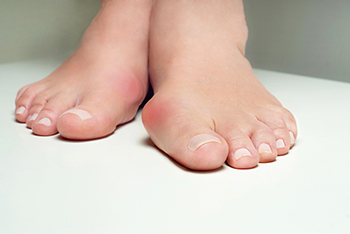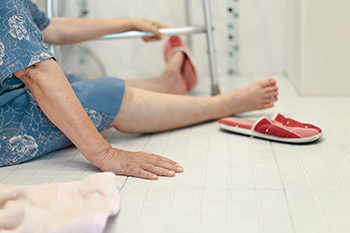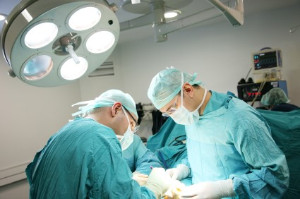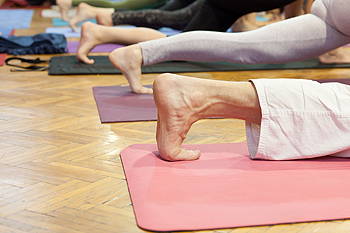Items filtered by date: January 2025
What Are Bunions?

A bunion is a bony bump that forms at the base of the big toe, caused by the tip of the toe leaning toward the second toe. This condition often results in pain, swelling, and redness surrounding the joint. Over time, bunions can make walking or wearing shoes uncomfortable, especially if the bump rubs against the inside of the shoe. The main cause of bunions is genetics, but they can also develop due to wearing tight or ill-fitting shoes, arthritis, or abnormal foot mechanics. The pressure on the big toe joint leads to misalignment and the growth of the bony bump. Treatment options for bunions include wearing wider shoes, using bunion pads, and doing foot exercises to improve flexibility. In more severe cases, a podiatrist might recommend custom orthotics or even surgery to correct the deformity. If you have developed a bunion, it is suggested that you schedule an appointment with a podiatrist.
If you are suffering from bunion pain, contact one of our podiatrists of Princeton Foot & Ankle Associates. Our doctors can provide the care you need to keep you pain-free and on your feet.
What Is a Bunion?
Bunions are painful bony bumps that usually develop on the inside of the foot at the joint of the big toe. As the deformity increases over time, it may become painful to walk and wear shoes. Women are more likely to exacerbate existing bunions since they often wear tight, narrow shoes that shift their toes together. Bunion pain can be relieved by wearing wider shoes with enough room for the toes.
Causes
- Genetics – some people inherit feet that are more prone to bunion development
- Inflammatory Conditions - rheumatoid arthritis and polio may cause bunion development
Symptoms
- Redness and inflammation
- Pain and tenderness
- Callus or corns on the bump
- Restricted motion in the big toe
In order to diagnose your bunion, your podiatrist may ask about your medical history, symptoms, and general health. Your doctor might also order an x-ray to take a closer look at your feet. Nonsurgical treatment options include orthotics, padding, icing, changes in footwear, and medication. If nonsurgical treatments don’t alleviate your bunion pain, surgery may be necessary.
If you have any questions, please feel free to contact our offices located in Princeton, and West Windsor, NJ . We offer the newest diagnostic and treatment technologies for all your foot care needs.
Preventing Bathroom Falls in Seniors

Bathrooms are one of the most common places where seniors experience falls due to slippery surfaces, limited space, and poor balance. Key risk areas include the shower or bathtub, where wet floors and awkward stepping increase fall likelihood. Toilet areas can also pose risks, especially when sitting down or standing up without support. To reduce these hazards, install grab bars near the toilet, shower, and bathtub. Non-slip mats inside and outside the tub can provide added stability. Adequate lighting and removing loose rugs can enhance safety. Seniors should wear non-slip footwear when using the bathroom. If you incur a fall, especially one resulting in foot or ankle pain, swelling, or difficulty walking it is strongly suggested that you visit a podiatrist for a proper diagnosis and treatment.
Preventing falls among the elderly is very important. If you are older and have fallen or fear that you are prone to falling, consult with one of our podiatrists from Princeton Foot & Ankle Associates. Our doctors will assess your condition and provide you with quality advice and care.
Every 11 seconds, an elderly American is being treated in an emergency room for a fall related injury. Falls are the leading cause of head and hip injuries for those 65 and older. Due to decreases in strength, balance, senses, and lack of awareness, elderly persons are very susceptible to falling. Thankfully, there are a number of things older persons can do to prevent falls.
How to Prevent Falls
Some effective methods that older persons can do to prevent falls include:
- Enrolling in strength and balance exercise program to increase balance and strength
- Periodically having your sight and hearing checked
- Discuss any medications you have with a doctor to see if it increases the risk of falling
- Clearing the house of falling hazards and installing devices like grab bars and railings
- Utilizing a walker or cane
- Wearing shoes that provide good support and cushioning
- Talking to family members about falling and increasing awareness
Falling can be a traumatic and embarrassing experience for elderly persons; this can make them less willing to leave the house, and less willing to talk to someone about their fears of falling. Doing such things, however, will increase the likelihood of tripping or losing one’s balance. Knowing the causes of falling and how to prevent them is the best way to mitigate the risk of serious injury.
If you have any questions, please feel free to contact our offices located in Princeton, and West Windsor, NJ . We offer the newest diagnostic and treatment technologies for all your foot care needs.
Types of Gout Surgery

Gout is a painful condition that can lead to severe joint damage over time. When conservative treatments such as medication and lifestyle changes fail to manage symptoms, surgery may become necessary. One option is to remove tophi, deposits of uric acid crystals that form under the skin often around joints. Tophi removal can relieve pain and prevent further joint damage. In cases where the joint is severely damaged, joint fusion may be recommended. This procedure involves fusing the bones of the affected joint to eliminate pain and improve stability. Another surgical option is joint replacement, which involves removing and replacing the damaged joint with a prosthetic. This is usually reserved for severe cases where joint function is significantly impaired. Gout surgery is typically considered when the condition causes chronic pain, deformity, or loss of function that nonsurgical methods cannot address. If you have painful gout episodes, it is strongly suggested that you are under the care of a podiatrist who can discuss treatment options with you.
Foot surgery is sometimes necessary to treat a foot ailment. To learn more, contact one of our podiatrists of Princeton Foot & Ankle Associates. Our doctors will assist you with all of your foot and ankle needs.
When Is Surgery Necessary?
Foot and ankle surgery is generally reserved for cases in which less invasive, conservative procedures have failed to alleviate the problem. Some of the cases in which surgery may be necessary include:
- Removing foot deformities like bunions and bone spurs
- Severe arthritis that has caused bone issues
- Cosmetic reconstruction
What Types of Surgery Are There?
The type of surgery you receive will depend on the nature of the problem you have. Some of the possible surgeries include:
- Bunionectomy for painful bunions
- Surgical fusion for realignment of bones
- Neuropathy decompression surgery to treat nerve damage
Benefits of Surgery
Although surgery is usually a last resort, it can provide more complete pain relief compared to non-surgical methods and may allow you to finally resume full activity.
Surgical techniques have also become increasingly sophisticated. Techniques like endoscopic surgery allow for smaller incisions and faster recovery times.
If you have any questions please feel free to contact our offices located in Princeton, and West Windsor, NJ . We offer the newest diagnostic and treatment technologies for all your foot and ankle needs.
It's Time for Beautiful Feet
How Yoga Stretches Can Help Flat Feet

Flat feet, also known as fallen arches, is a condition where the arch of the foot collapses, causing the entire sole to make contact with the ground. This can lead to discomfort, pain, and increased risk of other foot and joint problems. The condition can be caused by genetics, injury, or conditions such as obesity or aging. Yoga can be an effective way to relieve the discomfort caused by flat feet. Specific stretches help strengthen the muscles of the feet and lower legs, improving support for the arch. Poses such as downward dog, warrior 1, and tree pose focus on enhancing foot stability and flexibility. Additionally, yoga promotes proper alignment and body awareness, which can reduce the strain on the feet and prevent further complications. Regular yoga practice can improve overall foot strength and flexibility, providing relief and potentially preventing the progression of flat feet. If you have flat feet, it is suggested that you are under the care of a podiatrist who can offer effective relief tips, which can include specific yoga stretches.
Stretching the feet is a great way to prevent injuries. If you have any concerns with your feet consult with one of our podiatrists from Princeton Foot & Ankle Associates. Our doctors will assess your condition and provide you with quality foot and ankle treatment.
Stretching the Feet
Being the backbone of the body, the feet carry your entire weight and can easily become overexerted, causing cramps and pain. As with any body part, stretching your feet can serve many benefits. From increasing flexibility to even providing some pain relief, be sure to give your feet a stretch from time to time. This is especially important for athletes or anyone performing aerobic exercises, but anyone experiencing foot pain or is on their feet constantly should also engage in this practice.
Great ways to stretch your feet:
- Crossing one leg over the others and carefully pull your toes back. Do 10-20 repetitions and repeat the process for each foot
- Face a wall with your arms out and hands flat against the wall. Step back with one foot and keep it flat on the floor while moving the other leg forward. Lean towards the wall until you feel a stretch. Hold for 30 seconds and perform 10 repetitions for each foot
- Be sure not to overextend or push your limbs too hard or you could risk pulling or straining your muscle
Individuals who tend to their feet by regular stretching every day should be able to minimize foot pain and prevent new problems from arising.
If you have any questions, please feel free to contact our offices located in Princeton, and West Windsor, NJ . We offer the newest diagnostic and treatment technologies for all your foot care needs.

